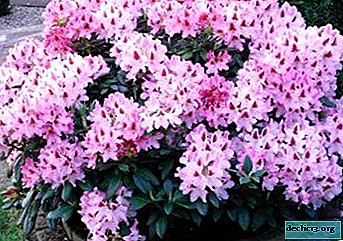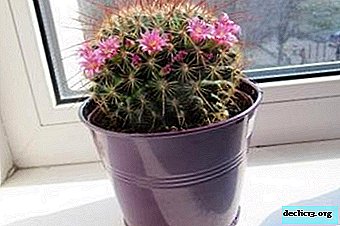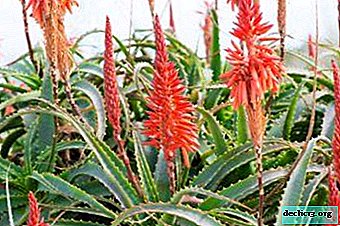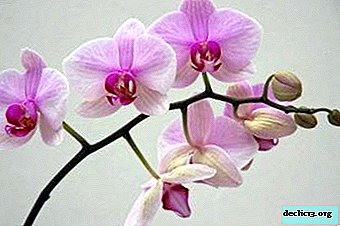Features of popular types of cactus Parody and care for them

Parody is the most common and popular cactus genus. What is evidenced by the creation of separate international organizations of lovers of parodies and their varieties. A photo of the plant gives a clear understanding of why this cactus has so many fans around the world.
In the article we’ll take a closer look at the most popular types of Parody cacti, also talk about the proper care of them, learn how cacti reproduce and bloom.
Botanical characteristics
Parody - a large genus belonging to the family Cactus. The Latin scientific name for the flower is Parodia.
In the modern classification, the genus Parody includes several types of cacti:
- Notocactus (learn about species of Notocactus here).
- Wigginzia.
- Eriocactus.
- Brazilicactus.
The numerous genus totals up to 150 varieties.
Appearance, history of occurrence, distribution geography
The first types of cactus parody were described at the end of the 19th century. New varieties were discovered in the 20s of the 20th century. Czech traveler and botanist A. Fritsch in Bolivia, in the north-west of Argentina, in Brazil, Paraguay. Natural habitat - rocky terrain, can grow in grass or among stones.
Parody was introduced to Europe in the mid-20th century. Subsequently, as a result of selection, the first representatives of a new parody - blood-flowered and snowy - were bred. The genus parody was named after the botanist Lorenzo Parody.
Reference! The stems are low, cylindrical or round, spherical in shape. The stem has numerous tuberous spiral ribs. Areoles are covered with thick white pubescence.Spines are dense, short, up to 40 pieces, radial. The length of the spines reaches 1 - 1.5 cm in length. The number of central spines 1 - 5, depending on the variety. Spikes - needles can be bent. The central spines are long, up to 3-4 cm. The fruits are dry, small, covered with small thorns.
Popular views: photos and descriptions
Golden-barbed or Parodia aureispina

The stem is small, spherical, up to 5 - 6 cm in diameter. The ribs are spiral. Spines are bristly, up to 35 - 40 pieces. The variety has 5 - 6 central spines of golden color. The largest of them is hook-shaped. Yellow flowers.
Leninghouse or Parodia leninghausii

The stems grow in small groups. The height of the stems reaches 70 - 90 cm in height. The diameter of the stem is up to 10 cm. Ribs 30. Spines are hairy, grow up to 2 - 6 cm in length, have a yellow tint. The flowers are light yellow, large, up to 6 - 7 cm in diameter.
Snowy or Parodia nivosa

The variety is distinguished by an oblong, slightly elongated stem. The stems are light green, medium length, grow up to 10 - 15 cm in height. The ribs are arranged in a spiral. Areoles densely pubescent with white spines. Spines are small, up to 2 cm. Flowering red hue. The flowers are large, up to 5 - 6 cm in diameter. About cacti with red flowers is described here.
Faust or Parodia faustiana

The miniature cactus has a spherical shape. The ribs are spiral. Areas densely pubescent with white lateral spines. The contrasting central thorns are black (are there cacti without thorns?). The flowers are medium, up to 4 - 5 cm in diameter. Petals are yellow, with a golden tint.
Fine seed or Parodia microsperma

Young cacti of this variety have the shape of a ball, with age they are elongated, acquiring a cylindrical shape. Ribs up to 20 pieces, twisted in a spiral. The lateral spines are thin, vitreous, up to 15 - 20 on each stem. The central spines are elongated, red-brown in color. One of them is twisted, has the shape of a hook. The flowers are golden, orange. Outside, the petals have a reddish tint.
Schwebs or Parodia schwebsiana

The diameter of the spherical stem reaches 12 cm. The height of an adult flower is up to 14 cm. Areoles are densely pubescent. At the top of the stem is a snow-white "cap" of dense areoles. The lateral spines are light brown, 1 cm in length. Central long, up to 2 cm. The flower is multi-petal, red.
Gorgeous or Parodia magnifica

Small spherical cactus. The stem has a bluish tint. Stem height - up to 15 cm. Ribs sharp, straight, deeply cut. Spines are all of the same length, up to 2 cm, bristly. The color of the spines is yellow with a golden hue. The flowers are pale, yellowish. Petals are wide, arranged in 2 rows. Diameter of flowers is up to 5 cm.
Maas or Parodia maasii

The stem is of medium height. It grows up to 15 cm in height. The shape of the stem becomes cylindrical over time. The ribs are twisted into a spiral, up to 20 pieces. 10 lateral spines located in the range. 4 central spines have a more powerful structure, the color is light brown. The central thorns are directed downward, one of them is twisted by a hook. The flowers are fiery red, medium.
How to care at home?
Temperature
The optimum air temperature in spring and summer is 23 - 25 ° C. It is important to observe the period of rest of the flower, in autumn and winter, the pots are rearranged in a cooler place. Unacceptable lowering the temperature to 7 ° C.
Watering
In spring and summer, watering should be regular, but moderate. In the intervals between irrigation, the topsoil should be well dried. You should beware of damp soil - a hotbed of pathogenic infections. In winter, watering is reduced.
Important! Additional humidification is not required, the view perfectly tolerates dry air.Water for irrigation should be filtered, clean. You can use rain or melt water.
Shine
Parody consumes a lot of light. Pots should be placed on the south, east and west sides. Thanks to the prickly coating, adult plants tolerate even direct sunlight.
Young flowers must be gradually adapted to bright light. Temporary shading of windows is required with a light curtain.
The daylight hours should be at least 10 - 11 hours. In winter, additional lighting should be used. special lamps.
Priming
The soil should be light, loose, nutritious.
 The soil should pass water well; for this, good drainage of crumb brick and broken expanded clay is necessary.
The soil should pass water well; for this, good drainage of crumb brick and broken expanded clay is necessary.
For planting, ready-made soil for cacti is used. You can prepare the soil mixture yourself:
- Sheet land - 1 h.
- Sod land - 1 h.
- Peat - 0.5 hours
- Coarse sand - 1 hour.
- Drainage layer.
Pruning
Only adult or damaged plants are cut off during transplantation.
Trimming Procedure: the tops of the stem, elongated from a lack of light, are cut off.
Damaged, rot-infected shoots should be trimmed. Sanitary pruning of dry and rotten root processes is carried out.
Places of slices are dried and sprinkled with crushed charcoal.
Top dressing
In the spring - summer period Parody requires top dressing. Fertilize the substrate 2 times in 3 to 4 weeks. Ready-made mineral potash and phosphorus fertilizers are used for succulents and cacti. Nitrogen supplements are used only in early spring, for good stalk growth.
Attention! Observe the dosage and feeding regimen. The solution should be slightly concentrated.Pot
For planting, low pots are used, up to 12 - 15 cm. It is better to use ceramic containers with a rough inner surface, which helps to fix the root. At the bottom of the pot, holes must be made for outflow of water and breathability.
Transfer
Young flowers can be replanted every year. Adult plants require rare movement, it is enough to transplant flowers once every 3 years. The transplant is carried out most often in spring or autumn, after flowering. It is necessary to transplant the flower if the roots do not fit in the previous container.
Transplantation scheme:
- Disinfect the new pot and substrate.
- At the bottom of the pot, a layer of purified drainage is poured, at least 2 cm.
- The flower is extracted with an earthen lump.
- Previously, the soil is soaked so as not to damage the root.
 Sick and dry roots are cut off.
Sick and dry roots are cut off.- The plant is transplanted by transshipment.
- The empty space of the pot is covered with new soil mixture.
- The substrate is pressed to fix the flower.
- Above recommends mulching the soil with small pebbles.
- You should refrain from watering for several days.
- Pots are installed in places with diffused bright light.
Wintering
In winter, the temperature is 10 - 13 ° C. Watering is reduced. It is enough to moisten the soil once a month.
Important! To prevent stale air, it is necessary to regularly air the room.Lighting is required for a full 10 to 12 hours. In the resting period, top dressing is not introduced.
Street content
- Parody does not tolerate cold, is not a winter-hardy species of cacti.
- In summer, pots are installed in the open air, you can dig pots in the garden.
- It is recommended to place plants in flower beds among stones, on alpine hills, in multi-tiered flower beds.
- Cover the parody from the rain, avoid places of detention near ponds. Soil water is also detrimental to flowers.
- In autumn, the pots are transported to the house.
- The main condition for the location of pots in the open air is bright sunlight.
Breeding
Kids
The separation of the lateral stems is carried out mainly in early spring.
Division scheme:
- The substrate is moistened.
- Lateral shoots are separated from the mother bush, preserving the roots.
- By transshipment method, while maintaining an earthen lump, the children are placed in separate containers.
- The temperature of the content is 20 - 23 ° C.
The difficulty of reproduction by children is that parody rarely shoots side shoots.
Seeds
The process is very lengthy. A feature of Parody is that seedlings grow for a long time, for 2 to 3 years. There is a high risk of contamination of the soil and the formation on it of a detrimental for seedlings plaque of green algae. The sowing procedure is carried out in the spring.
Sowing pattern:
 Spacious, shallow containers fill the drainage layer.
Spacious, shallow containers fill the drainage layer.- The soil mixture is evenly distributed over the drainage.
- Seeds are placed without deepening.
- Capacities are covered with film or glass.
- The greenhouse is aired daily.
- Air temperature - up to 25 ° С.
- Shoots appear quickly, within 7 days.
- The glass is removed.
- Tanks are rearranged in a bright room for growing seedlings.
- Watering is moderate.
Features of growing and dividing in open ground
- The soil must be drained. The drainage layer is not more than 2 - 2.5 cm.
- In the open air, the plant does not tolerate both overflow and overdrying of the soil.
- In open ground, the stem from poor-quality watering can harden at the base, the composition of the fibers that do not pass water and air is deformed.
- Irrigation with tap water is contraindicated.
- The soil is mulched with well-rotted leaves.
Flowering: when and how?
Flowering usually occurs in spring or summer, depending on the variety. Flower stems are in the form of a tube, slightly shortened. The tubes are densely covered with scales or small spines. The buds are formed at the very top of the stem. Flowers are close to each other, forming a lush bouquet.
The color scheme is diverse - yellow, golden, red colors and shades. Inflorescences can be single, can connect up to 7 - 10 flowers.
What if I don’t pick up the buds?
In violation of the light regime, flowering is problematic.
Full-fledged daylight all year round - the guarantee of abundant flowering.
Also, to stimulate the growth of buds, flower growers recommend minimizing soil moisture. Unfortunately, at home it is rather difficult to achieve colorful flowering.
Diseases and Pests
- From excessive moisture of the substrate, high humidity, low temperature, root and stem rot is formed. An urgent transplant and quarantine of infected specimens is required.
- When kept in summer in the garden in the open air, the flowers are susceptible to damage to the scale insects, mealybug. The stems and soil should be treated with a solution of phytoerm.
- In the heat from dry soil, stale air, a spider mite may appear. Spraying flowers with actara or other insecticides will save.
Like many cacti, highly decorative Parody requires special attention, proper care, timely pruning and transplanting.

 Sick and dry roots are cut off.
Sick and dry roots are cut off. Spacious, shallow containers fill the drainage layer.
Spacious, shallow containers fill the drainage layer.















